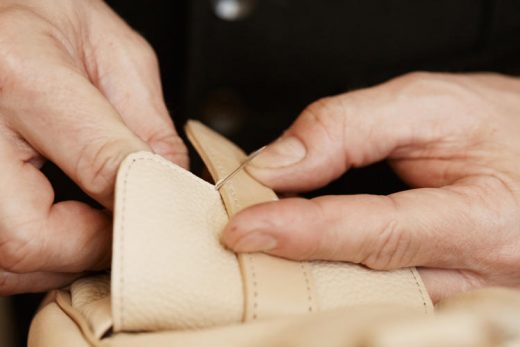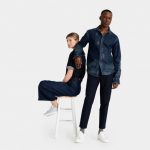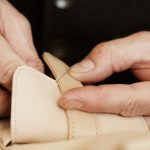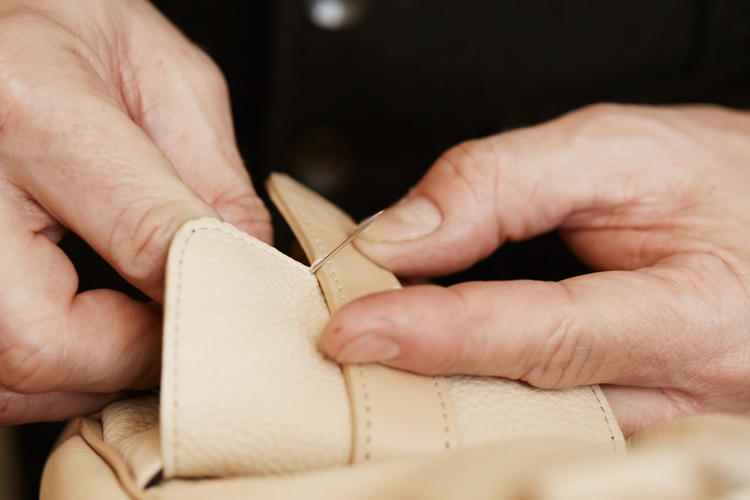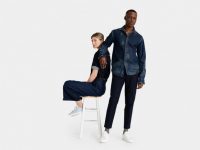The Luxury Bag Brand That’s Reinventing Made-To-Order
These days, bespoke fashion is the epitome of luxury. Think London’s Savile Row, where people pay thousands for made-to-measure suits, or ateliers in Milan or Paris, where a predominantly female clientele commission one-of-a-kind handmade gowns.

A hundred years ago, though, customized clothing was the norm. Manhattan was sprinkled with little shops where middle-class families could have trousers sewn from scratch or bags hand-stitched by expert artisans. It wasn’t until clothing companies moved toward more efficient and less expensive mass-manufacturing models that these workshops began to disappear.
And now, a Manhattan-based startup called 1Atelier is redefining bespoke fashion for the digital age, combining old-fashioned craftsmanship and modern technology in ways that could signal the future of customization.
When you walk into 1Atelier’s studio in the Garment District, tables are strewn with large bolts of premium leather, from full-grain cowhide to more exotic varieties of snake and crocodile. You can watch a master craftsman put the finishing touches on satchels, clutches, and hobos, each designed to the exact specifications of the customer. One saddle bag is made of champagne-colored python skin with a contrasting pink trim; a colorful tote comes in fuchsia, orange, and blue. There’s a little machine that stamps the owner’s name in gold lettering onto a label inside the bag.
In the past, a client would need to visit a workshop to order a customized bag, but at 1Atelier, she can do everything online. The company’s website allows customers to pick a style, then play with different colors and textures until they’ve dreamed up their perfect sack. The end product costs between $295 and $8,400, which puts the brand at the lower end of the luxury bag spectrum. But unlike Chanel or Céline, which requires six months or longer to ship a bespoke order, 1Atelier products are delivered to the customer in 21 days.
That’s all thanks to technology, from the snazzy customization tool on 1Atelier’s website to the company’s backend systems that make the supply chain and manufacturing models of efficiency. “Technology is the lever that allows us to transform the entire luxury experience,” says CEO Stephanie Sarka. Even the brand’s logo reflects how deeply 1Atelier’s mission is intertwined with tech: the number one surrounded by a circle resembles the power-on symbol.
Sarka, who has spent her career in fashion, e-commerce, and angel investing, cofounded 1Atelier last year with two other veterans of the fashion industry, Frank Zambrelli and Anthony Luciano. She believes that there’s a massive market opportunity to bring customization to the luxury accessories sector, which is worth $47 billion worldwide. According to a report in the Wall Street Journal from last year, 56% of luxury consumers say customization is increasingly important to them—an uptick that reflects a broader trend in consumer behavior. Deloitte research revealed that 36% of people want personalized goods and services in their everyday shopping experiences. “This makes sense,” says Zambrelli, who worked at Chanel, Coach, and Judith Leiber before cofounding 1Atelier and becoming its creative director. “We’re now surrounded by a culture in which we are encouraged to customize everything from our Facebook profile to the color of our smartphone. It was inevitable that this mind-set would enter the luxury industry.”

Major design houses have taken note. You can now monogram your Louis Vuitton bag or add your own combination of graphics—bees, tigers, flowers—to your Gucci bag, jacket, or shoes. You can choose the heel, color, and fabric on Manolo Blahnik’s classic BB stiletto. Jimmy Choo offers a collection of clip-ons and buttons to adorn your heels or clutch. For the 35th anniversary of Ferragamo’s iconic Vara and Varina shoes, you could customize these styles to your taste. And at the Opening Ceremony SoHo location, there’s an embroidery station where you can add the imprint of your choice to a shirt or jacket.
But as Zambrelli points out, these are personalized details on a few products from a collection. “These are condiments on an entrée, rather than a handcrafted meal,” he says.
Offering a more complete customization experience, where the customer has a hand in the entire design process, presents a logistical challenge for big brands, whose supply chain and manufacturing networks usually span multiple countries. In 2011, for instance, Burberry offered a bespoke service that allowed customers to alter every aspect of its iconic trench coat, from the cut to the fabric to the color, for between $1,800 and $8,800. But when the service failed to be profitable, Burberry quietly shut it down in 2015 and launched a simpler alternative, the Scarf Bar, where shoppers can monogram their initials onto scarves for $475 to $995.
Sarka and Zambrelli kept these case studies in mind when they built 1Atelier. “It’s hard to customize at scale unless you’re uniquely dedicated to it,” Sarka says. “We’ve been building our systems and infrastructure, thinking about how we can scale everything from the production to the user experience.”
Hence, the crucial role of technology.

In their research, the founders discovered that many women feel intimidated by too much choice. So they reasoned that the key to creating a website that clients would enjoy was to offer them ample options without overwhelming them.
Shoppers start by selecting one of nine silhouettes that Zambrelli designed based on classic handbag shapes. Then they select the leather, color, piping, and hardware. To guide them through the customization process, the site gives examples of fully designed bags, which I found useful when I was playing around on the site. I was drawn to bags with muted color palettes, full of blushes and celadons, but I quickly identified things I wanted to tweak: gold rather than silver hardware, no side pocket, more contrast on the piping. In the end, the bag I designed was totally different from the one I began with. And the vast majority of customers do get a one-of-a-kind product. “Of all the bags that we have sold, there’s only been one instance of the same design, a black python clutch,” Sarka says. “And even then, one of them had a chain.”
Once you’ve placed your order and your bag is being assembled, 1Atelier keeps you involved as best it can, sending emails every few days with photos showing, for instance, leather being cut or your name being stamped onto the label. “We think that this ongoing conversation with the consumer is ultimately what building a brand is all about,” Sarka says.
On the backend, Sarka is gathering plenty of user data, including consumer demographics, popular bag silhouettes, and average time to design a bag. While the company is barely a year old, it’s already using this information to improve the user experience. “We’re thinking about how to look algorithmically at decisions that the customer has made so we can provide suggestions along the way,” Zambrelli says. “For instance, we might discover that a customer who chooses white python subsequently goes on to choose one of four materials. We can use this to offer guidance as they design their bags.”
On the production side of the equation, 1Atelier uses logistical software to streamline the process. When orders come in, the team knows exactly what raw materials they will need and how many hours it will take to make each bag. Rather than stocking the workshop with hundreds of leathers that would require a hefty capital investment, the company orders skins from Italy and France to cover only the needs for each individual order. Over the course of Zambrelli’s career in the luxury bag industry, he’s built deep relationships with tanneries in Europe that can send products in 48 hours. Orders are also bundled together to make the workflow more efficient: If two customers want to use black tumbled leather, for example, the craftsman will cut the skins at the same time.
So who is buying these handbags? A very particular consumer—one who enjoys luxury products, has a disposable income, and is comfortable paying a high price for a product that doesn’t have the name recognition of an Hermès or a Louis Vuitton. “These are women who have already bought Chanel purses and no longer want their handbag to be a billboard for a brand,” Sarka says. This might seem like an idiosyncratic mix, but Sarka explains that Facebook and Google allow 1Atelier to target users based on psychographic profiles. And the approach has worked so far. In just under a year, the company has sold several hundred bags; a quarter of the purchasers have bought more than one.
That’s a promising beginning, but the business wouldn’t be sustainable if 1Atelier couldn’t keep the costs low by making the bags in New York. While other luxury brands have managed overhead by consolidating manufacturing in big factories, 1Atelier makes the bags onsite in a relatively small urban workshop. Zambrelli says this allows them to charge 30% less than comparable styles from other luxury brands. “It’s innately sustainable,” Zambrelli says. “There’s no warehouse of materials or finished stock that we have to dispose of if they are not sold. It’s remarkably efficient; there’s no waste and there’s nothing we’re throwing into a landfill.” Even if 1Atelier outgrows its current studio, the founders say they are committed to staying in Manhattan.
As word about 1Atelier spreads, Sarka hopes that people will begin to associate the brand with high-quality materials and craftsmanship. Zambrelli has included subtle touches to make a 1Atelier bag identifiable: a logo on the front or the side, wide piping, unique hardware engraved with a tiny logo. Eventually, if the brand does take off, women familiar with luxury products will be able to spot these characteristics in the way they immediately recognize the iconic Chanel 2.55 bag or the Hermès Birkin bag. “A couple of our repeat customers have asked us whether we can increase the size of our logo on the bag,” Sarka says. “We take that as a sign that we’re doing something right.”
related video: How Gwyneth Paltrow Created A “Real Brand” With Goop
In 1Atelier’s little studio in the Garment District, you can get a glimpse of old-fashioned craftsmanship at work.

But it has incorporated clever technological updates, making it better suited to today’s consumer.
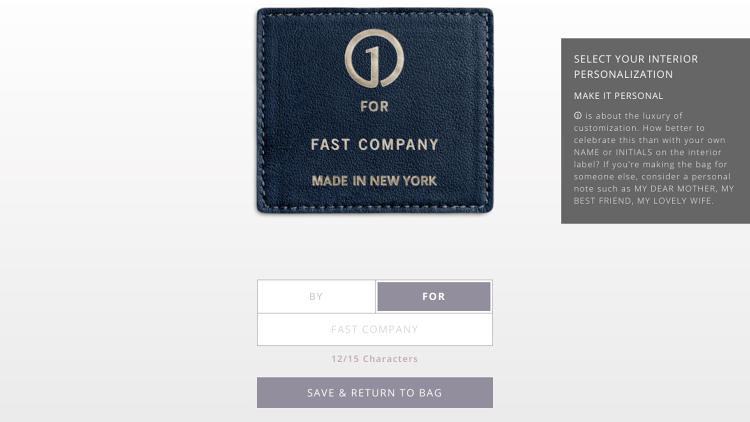
In the past, a woman would need to visit a workshop to create a bespoke bag but at 1Atelier, she can do everything online.

The company’s website allows customers to pick a bag style, then play with different colors and textures until they’ve dreamed up their perfect bag.

The end product costs between $295 and $8,400, which puts the brand at the lower end of the luxury bag spectrum.
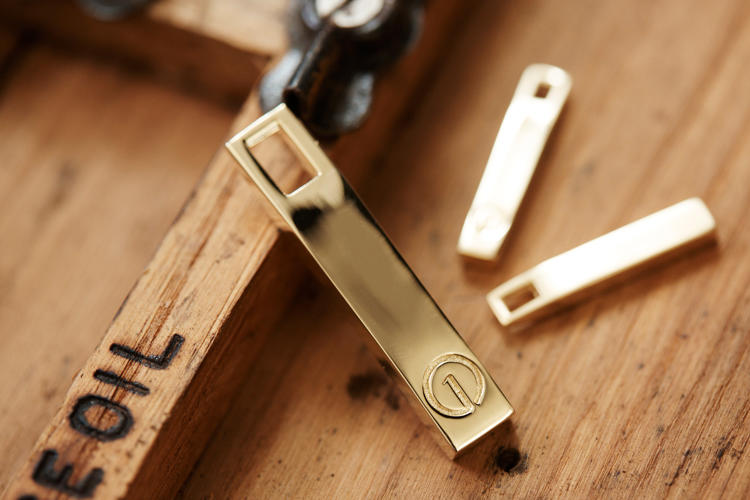
But unlike Chanel or Céline, which requires six months or longer to ship a bespoke order, 1Atelier products are delivered to the customer in 21 days.

How? Through technology in the customization tool on the website and the backend systems that make the supply chain and manufacturing efficient.

Fast Company , Read Full Story
(28)

